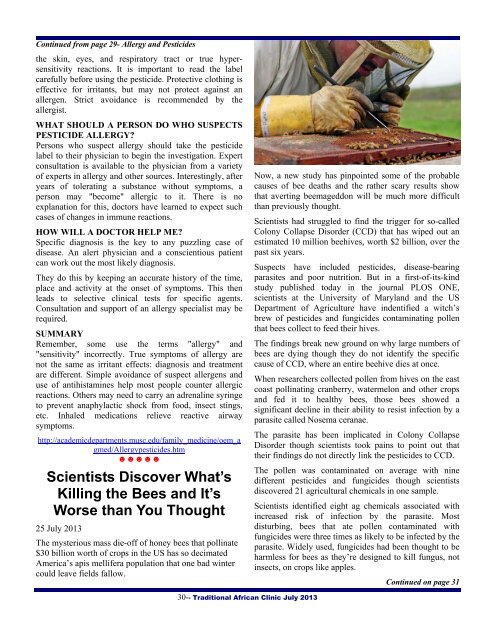toxicity - pesticides, herbicides and insecticides - Blackherbals.com
toxicity - pesticides, herbicides and insecticides - Blackherbals.com
toxicity - pesticides, herbicides and insecticides - Blackherbals.com
Create successful ePaper yourself
Turn your PDF publications into a flip-book with our unique Google optimized e-Paper software.
Continued from page 29- Allergy <strong>and</strong> Pesticidesthe skin, eyes, <strong>and</strong> respiratory tract or true hypersensitivityreactions. It is important to read the labelcarefully before using the pesticide. Protective clothing iseffective for irritants, but may not protect against anallergen. Strict avoidance is re<strong>com</strong>mended by theallergist.WHAT SHOULD A PERSON DO WHO SUSPECTSPESTICIDE ALLERGY?Persons who suspect allergy should take the pesticidelabel to their physician to begin the investigation. Expertconsultation is available to the physician from a varietyof experts in allergy <strong>and</strong> other sources. Interestingly, afteryears of tolerating a substance without symptoms, aperson may "be<strong>com</strong>e" allergic to it. There is noexplanation for this, doctors have learned to expect suchcases of changes in immune reactions.HOW WILL A DOCTOR HELP ME?Specific diagnosis is the key to any puzzling case ofdisease. An alert physician <strong>and</strong> a conscientious patientcan work out the most likely diagnosis.They do this by keeping an accurate history of the time,place <strong>and</strong> activity at the onset of symptoms. This thenleads to selective clinical tests for specific agents.Consultation <strong>and</strong> support of an allergy specialist may berequired.SUMMARYRemember, some use the terms "allergy" <strong>and</strong>"sensitivity" incorrectly. True symptoms of allergy arenot the same as irritant effects: diagnosis <strong>and</strong> treatmentare different. Simple avoidance of suspect allergens <strong>and</strong>use of antihistamines help most people counter allergicreactions. Others may need to carry an adrenaline syringeto prevent anaphylactic shock from food, insect stings,etc. Inhaled medications relieve reactive airwaysymptoms.http://academicdepartments.musc.edu/family_medicine/oem_agmed/Allergy<strong>pesticides</strong>.htm☻☻☻☻☻Scientists Discover What’sKilling the Bees <strong>and</strong> It’sWorse than You Thought25 July 2013The mysterious mass die-off of honey bees that pollinate$30 billion worth of crops in the US has so decimatedAmerica’s apis mellifera population that one bad wintercould leave fields fallow.Now, a new study has pinpointed some of the probablecauses of bee deaths <strong>and</strong> the rather scary results showthat averting beemageddon will be much more difficultthan previously thought.Scientists had struggled to find the trigger for so-calledColony Collapse Disorder (CCD) that has wiped out anestimated 10 million beehives, worth $2 billion, over thepast six years.Suspects have included <strong>pesticides</strong>, disease-bearingparasites <strong>and</strong> poor nutrition. But in a first-of-its-kindstudy published today in the journal PLOS ONE,scientists at the University of Maryl<strong>and</strong> <strong>and</strong> the USDepartment of Agriculture have indentified a witch’sbrew of <strong>pesticides</strong> <strong>and</strong> fungicides contaminating pollenthat bees collect to feed their hives.The findings break new ground on why large numbers ofbees are dying though they do not identify the specificcause of CCD, where an entire beehive dies at once.When researchers collected pollen from hives on the eastcoast pollinating cranberry, watermelon <strong>and</strong> other crops<strong>and</strong> fed it to healthy bees, those bees showed asignificant decline in their ability to resist infection by aparasite called Nosema ceranae.The parasite has been implicated in Colony CollapseDisorder though scientists took pains to point out thattheir findings do not directly link the <strong>pesticides</strong> to CCD.The pollen was contaminated on average with ninedifferent <strong>pesticides</strong> <strong>and</strong> fungicides though scientistsdiscovered 21 agricultural chemicals in one sample.Scientists identified eight ag chemicals associated withincreased risk of infection by the parasite. Mostdisturbing, bees that ate pollen contaminated withfungicides were three times as likely to be infected by theparasite. Widely used, fungicides had been thought to beharmless for bees as they’re designed to kill fungus, notinsects, on crops like apples.Continued on page 3130-- Traditional African Clinic July 2013
















